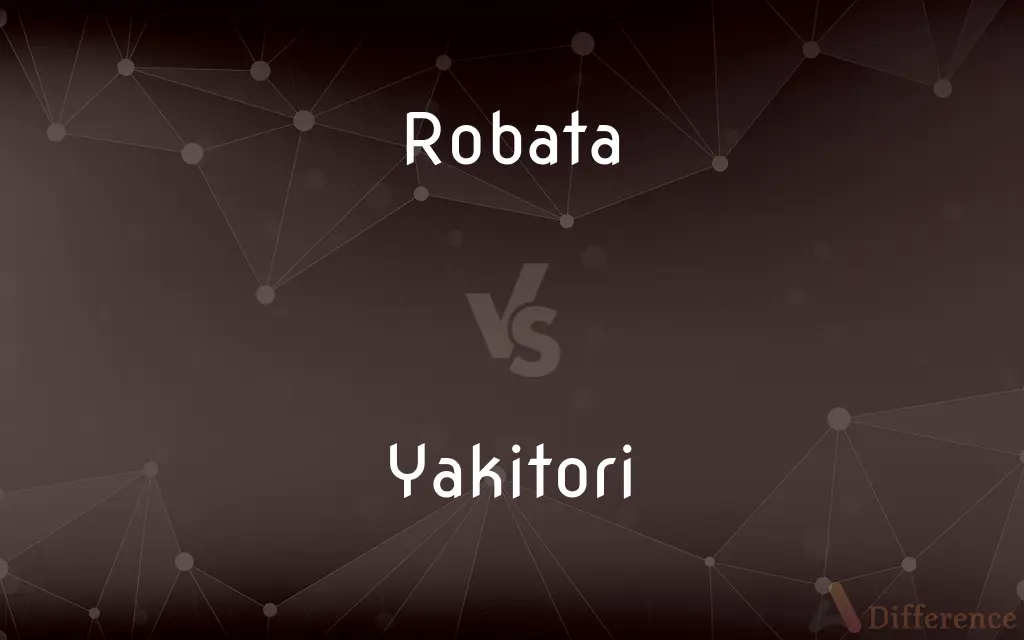Robata vs. Yakitori — What's the Difference?
Edited by Tayyaba Rehman — By Fiza Rafique — Updated on April 4, 2024
Robata involves slow-grilling over hot charcoal, emphasizing a variety of foods, while Yakitori specifically focuses on skewered chicken parts, quickly grilled.

Difference Between Robata and Yakitori
Table of Contents
ADVERTISEMENT
Key Differences
Robata, or robatayaki, is a Japanese cooking method where food is slow-grilled over hot charcoal, capturing a smoky flavor. This technique allows for a broad selection of ingredients, including seafood, vegetables, and meat, to be cooked meticulously. Whereas, Yakitori translates to "grilled chicken" and is a specific type of Japanese skewered chicken. The focus is on different parts of the chicken, from breast to intestines, grilled over a charcoal fire with either a salt or a tare (soy-based sauce) seasoning.
The atmosphere and setting of robata dining often replicate that of a traditional Japanese hearth, providing a communal and interactive eating experience. Patrons enjoy watching their food being cooked over the open grill, enhancing the dining experience through visual and aromatic appeal. On the other hand, yakitori is commonly served in casual settings like izakayas (Japanese pubs), where it's enjoyed as a snack or a complement to drinks, emphasizing its role as a social food that pairs well with alcohol.
Robata grilling emphasizes the inherent flavors of the ingredients through slow cooking, which allows the food to cook evenly and retain moisture. This method highlights the natural taste and texture of the ingredients. In contrast, yakitori's quicker grilling process focuses on achieving a balance between the smoky flavor from the charcoal and the savory or sweet notes of the seasonings used, creating a unique taste profile for each skewer.
While robata cuisine can include an array of ingredients, yakitori is known for its inventive use of chicken, utilizing virtually every part of the bird. This not only minimizes waste but also offers a variety of flavors and textures, from tender breast meat to crispy skin and cartilage. Yakitori chefs pride themselves on their ability to make each part of the chicken deliciously palatable.
Despite their differences, both robata and yakitori share the commonality of being social dining experiences. They foster a sense of community and enjoyment around the grill, whether it's the diverse offerings of robata or the specialized focus of yakitori. Each has its unique charm and culinary delights, contributing to the rich tapestry of Japanese cuisine.
ADVERTISEMENT
Comparison Chart
Definition
A method of cooking food slowly over hot charcoal.
Skewered chicken grilled over charcoal.
Ingredients
Includes seafood, vegetables, and various meats.
Exclusively uses different parts of chicken.
Cooking Time
Slow-grilling to emphasize flavor and texture.
Quickly grilled, focusing on smokiness and seasoning.
Setting
Often in restaurants mimicking a traditional hearth.
Served in casual izakayas as a snack or with drinks.
Flavor Focus
Highlights the natural flavors of diverse ingredients.
Balances the smoky charcoal flavor with savory or sweet seasonings.
Compare with Definitions
Robata
Focuses on slow-cooking ingredients.
Vegetables prepared robata style retain their crisp texture and natural taste.
Yakitori
Involves various chicken parts.
From thigh to liver, the yakitori selection showcased the chicken's versatility.
Robata
Offers a communal dining experience.
We enjoyed watching our dinner being prepared on the robata grill.
Yakitori
Japanese skewered chicken grilled over charcoal.
The yakitori was seasoned perfectly, with a delightful char.
Robata
Emphasizes a variety of foods.
The robata menu featured everything from mushrooms to steak.
Yakitori
Quick-grilling method.
Yakitori chefs masterfully grill chicken skewers to smoky perfection in minutes.
Robata
Celebrates the art of grilling.
Robata chefs are skilled in drawing out subtle flavors through grilling.
Yakitori
Served in casual dining settings.
We ordered several rounds of yakitori at our favorite izakaya.
Robata
A Japanese grilling technique using charcoal.
The seafood was cooked robata style, enhancing its natural flavors.
Yakitori
Paired with salt or tare sauce.
Each yakitori skewer was brushed with a rich, flavorful tare sauce.
Robata
A charcoal grill used to prepare Japanese food for customers seated around the cooking area.
Yakitori
Yakitori (Japanese: 焼き鳥) (literally 'grilled bird') is a Japanese type of skewered chicken. Its preparation involves skewering the meat with kushi (串), a type of skewer typically made of steel, bamboo, or similar materials.
Robata
A restaurant featuring such a grill.
Yakitori
A dish of bite-sized marinated chicken pieces grilled on skewers.
Yakitori
A Japanese shish kebab-type dish made with small pieces of chicken or other ingredients cooked on skewers, often marinated in soy sauce or seasoned with salt.
Common Curiosities
Can you eat yakitori as a main dish?
While traditionally enjoyed as a snack or with drinks, yakitori can also serve as a main dish, especially when ordered in larger quantities.
What is robata?
Robata refers to a Japanese method of slow-grilling food over hot charcoal, highlighting the natural flavors of a wide range of ingredients.
Is robata cooking limited to specific types of food?
No, robata cooking is versatile, accommodating seafood, meat, and vegetables, showcasing the method's adaptability to different ingredients.
Are there vegetarian options in robata cuisine?
Yes, robata cuisine includes a variety of vegetarian options, such as grilled vegetables and tofu, making it inclusive for different dietary preferences.
What is unique about yakitori seasoning?
Yakitori seasoning is unique for its simplicity, often relying just on salt or a savory-sweet tare sauce to enhance the chicken's natural flavors.
Can robata and yakitori be found outside of Japan?
Yes, the popularity of Japanese cuisine globally has led to robata and yakitori restaurants opening in many countries outside of Japan.
Why is yakitori popular in Japan?
Yakitori is popular for its delicious taste, versatility in using different parts of the chicken, and its role as a perfect accompaniment to alcoholic beverages.
Can yakitori be considered fast food in Japan?
Given its quick preparation and casual serving settings, yakitori can be seen as a type of fast food in Japan, though it is much fresher and made to order.
What does yakitori mean?
Yakitori means "grilled chicken" in Japanese, and it refers to skewered chicken parts grilled over charcoal, usually seasoned with salt or a soy-based sauce.
How does the cooking time differ between robata and yakitori?
Robata involves a slow-cooking process to thoroughly cook and enhance flavors, whereas yakitori is quickly grilled for a smoky taste.
How do robata and yakitori dining experiences differ?
Robata dining often provides a communal, interactive atmosphere akin to a traditional Japanese hearth, while yakitori is typically enjoyed in more casual settings like izakayas.
What makes robata grilling unique?
The unique aspect of robata grilling lies in its method of slow-cooking over hot charcoal, which intensifies the natural flavors and textures of the food.
Is there a specific type of charcoal used for robata and yakitori?
Yes, both robata and yakitori traditionally use binchotan, a high-quality Japanese charcoal known for its ability to cook food evenly without overpowering smoke.
How do chefs learn robata or yakitori grilling techniques?
Chefs typically learn through apprenticeship, spending years mastering the precise techniques and timing required for robata or yakitori grilling.
Share Your Discovery

Previous Comparison
Avenue vs. Venue
Next Comparison
Workshop vs. LessonAuthor Spotlight
Written by
Fiza RafiqueFiza Rafique is a skilled content writer at AskDifference.com, where she meticulously refines and enhances written pieces. Drawing from her vast editorial expertise, Fiza ensures clarity, accuracy, and precision in every article. Passionate about language, she continually seeks to elevate the quality of content for readers worldwide.
Edited by
Tayyaba RehmanTayyaba Rehman is a distinguished writer, currently serving as a primary contributor to askdifference.com. As a researcher in semantics and etymology, Tayyaba's passion for the complexity of languages and their distinctions has found a perfect home on the platform. Tayyaba delves into the intricacies of language, distinguishing between commonly confused words and phrases, thereby providing clarity for readers worldwide.
















































